|
|
|
|
|
|
From the geschlossener Kastenaufbau to the geschlossener Einheitsaufbau
The development of closed superstructures on lorry chassis and their designations of the Reichswehr and Wehrmacht
|
|
|
|
|
|
|
|
There are obscurities concerning the development, usage and designation of geschlossenen Aufbauten - closed superstructures - based on motor vehicles of the Reichswehr and Wehrmacht inspired by incorrect information in the literature and the internet. Simplifying terms like Funkkoffer - radio box body - or Einheitskoffer - standardised box body - are often used. This article should provide clarity about the development, usgae and designations of closed superstructures based on original documents and technical manuals.
|
|
|
|
|
|
|
|
In the 1920s, the Reichswehr used exclusively commercial motor vehicles with superstructures which were adapted to the military use. For example, there wa a Funkkraftwagen - radio motor vehicle - with geschlossener Aufbau - closed superstructure - which was constructed as state of the art by Stabbrettern - rod-planks. According to that, it was heavy and expensive.
|
|
|
|
|
|
|
|
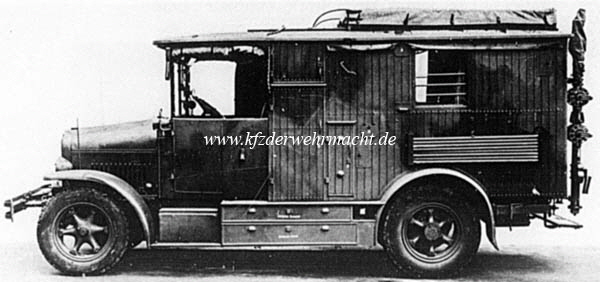 This image out of the D 937/1 from 1st May 1932 illustrates a Magirus 2 C with a geschlossener Aufbau made from Stabbrettern as leichter Funkkraftwagen - light radio motor vehicle - like it was manufactured from about 1922 to 1929. This image out of the D 937/1 from 1st May 1932 illustrates a Magirus 2 C with a geschlossener Aufbau made from Stabbrettern as leichter Funkkraftwagen - light radio motor vehicle - like it was manufactured from about 1922 to 1929.
|
|
|
|
|
|
|
|
In the course of the Erstes Motorisierungsprogramm der Reichswehr - first programm for motorising the Reichswehr - from 1926 the development of six-wheel chassis and a whole range of special superstructures, which should be built up on these chassis, was developed. A first overview about the developed superstructures was provided by the Bilderatlas der Heeresüblichen Kraftfahrzeuge nebst Charakteristik - pictorial atlas of the army common motor vehicles with their charcteristics - from 1st December 1932 with additions from 15th March 1933. There the Kleinfunkkraftwagen - small radio motor vehicle - (Kfz. 61) is illustrated whose superstructure is still described as geschlossener Kastenaufbau mit Fenstern und Türen ohne Inneneinrichtung (Ausrüstung im Innern je nach Verwendung) - closed box body with windows and doors without interior equipment (interior equipment according to usage) - in the same way like the superstructure of the Kfz. 72.
|
|
|
|
|
|
|
|
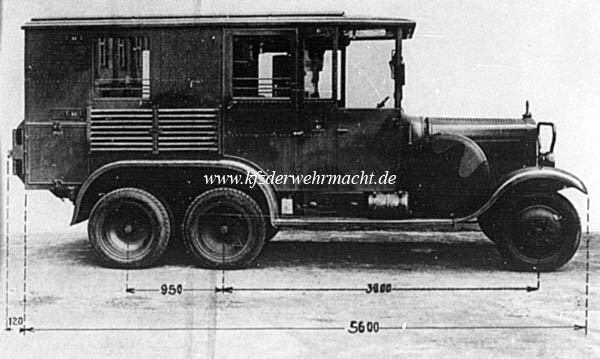 This image of the Kleinfunkkraftwagens (Kfz. 61) based on a Mercedes-Benz Typ G 3 originates from the D 937/1. Further trial superstructures were procured based on the NAG-Voran. These early closed superstructures did not correspond to the later serial models.. This image of the Kleinfunkkraftwagens (Kfz. 61) based on a Mercedes-Benz Typ G 3 originates from the D 937/1. Further trial superstructures were procured based on the NAG-Voran. These early closed superstructures did not correspond to the later serial models..
|
|
|
|
|
|
|
|
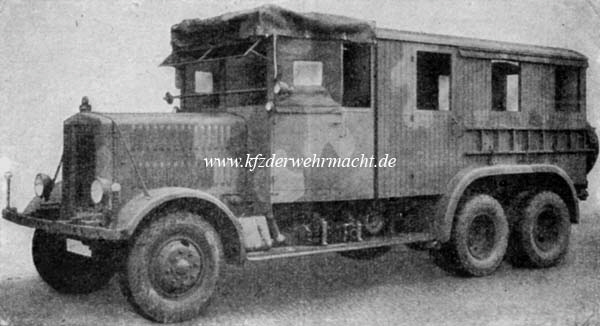 Also based on the m. gl. Lkw. (o) closed superstructures were developed in the early 1930s. The vehicle in the illustration is a Wetterkraftwagen - meteorologic motor vehicle - (Kfz. 72), like it is shown in the Bilderatlas der Heeresüblichen Kraftfahrzeuge nebst Charakteristik from 1932. There this illustration was alo used to illustrate all other variants of the Kfz. 72. Unchanged, this illustration was still used in the D 600 from 1940. In the case of the closed superstructures of the later serial models, the superstructure was seperated from the driver’s cab. Also based on the m. gl. Lkw. (o) closed superstructures were developed in the early 1930s. The vehicle in the illustration is a Wetterkraftwagen - meteorologic motor vehicle - (Kfz. 72), like it is shown in the Bilderatlas der Heeresüblichen Kraftfahrzeuge nebst Charakteristik from 1932. There this illustration was alo used to illustrate all other variants of the Kfz. 72. Unchanged, this illustration was still used in the D 600 from 1940. In the case of the closed superstructures of the later serial models, the superstructure was seperated from the driver’s cab.
|
|
|
|
|
|
|
|
Seemingly, the serial versions of the special superstructures were numbered consecutively after the trial phase. No exact data could be found. According to the H.Dv. 398 K and K1 Gerätverzeichnis Kraftfahrgerät from 31st March 1938 the following figure implies:
geschlossener Aufbau 1: Krankenkraftwagen (Kfz. 31)
geschlossener Aufbau 2: Beleuchtungskraftwagen (Kfz. 41), Beleuchtungsanhänger (Ah. 51)
geschlossener Aufbau 3: Werkstattkraftwagen (Kfz. 51)
geschlossener Aufbau 4: Fernschr.Kw., Fsp.Betr.Kw., Peilkw. a & b, Kabelmesskw., Verst. Kw. (all Kfz. 61), Fu. Kw. (Kfz. 61/1)
geschlossener Aufbau 6: Wett. Kw., Druck Kw., Fsp. Betr. Kw., Fu. Horch Kw. a & b, Verst. Kw., Fernschr. Kw., Fu. Kw. a, b & c, Fu. Betr. Kw. (all Kfz. 72), Fernschr. Kw. (Kfz. 72/1)
geschlossener Aufbau 8: Flak Meßtr. Kw. I and II (Kfz. 74)
geschlossener Aufbau 11: Sammlerkraftwagen (Kfz. 42), Nachrichtenwerkstattkraftwagen (Kfz. 42)
geschlossener Aufbau 12: Wett. Kw., Schallausw. Kw., Schallaufn. Kw., Lichtausw. Kw., Verm. Ausw. Kw., Stb. Ausw. Kw., Druck Kw. (all Kfz. 62)
geschlossener Aufbau 13: Vorw. Kw., Lichtmeßst. Kw., Schallmeßst. Kw., Schallmeßger. Kw. (all Kfz. 63)
No allocations could be found for the numbers 5, 7, 9 and 10. It is doubtfull that these superstructures were allready fully standardised superstructures, because different lorry chassis were used for these Kfz. Most probably the numbers corresponded to a standardised construction with defined position and number of doors, windows and stowage compartments.
|
|
|
|
|
|
|
|
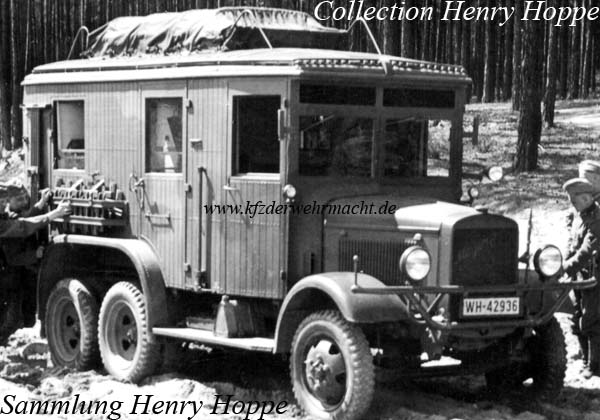 This design of the geschlossener Aufbaus based on a Magirus M 206 corresponded to the serial model of the Kfz. 61 like it was used as leichter Funkkraftwagen - light radio motor vehicle - (Kfz. 61), Peilkraftwagen - bearing motor vehicle - a and b (Kfz. 61) and Schlüsselkraftwagen - code motor vehicle - (Kfz. 61). In the D 809 Gerätnachweis für einen Schlüsseltrupp (mot) (mit Kfz. 61) from 28th April 1936, this superstructure was designated as geschlossener Aufbau 4. In the D 804/2 Gerätnachweis für einen mittleren Funktrupp b (mot) mit Funkkraftwagen (Kfz. 61)... from 28th February 1940, the superstructure was designated only as geschlossener Aufbau. Obviously, the numbering of the superstructures was ommitted in the late 1930s. This design of the geschlossener Aufbaus based on a Magirus M 206 corresponded to the serial model of the Kfz. 61 like it was used as leichter Funkkraftwagen - light radio motor vehicle - (Kfz. 61), Peilkraftwagen - bearing motor vehicle - a and b (Kfz. 61) and Schlüsselkraftwagen - code motor vehicle - (Kfz. 61). In the D 809 Gerätnachweis für einen Schlüsseltrupp (mot) (mit Kfz. 61) from 28th April 1936, this superstructure was designated as geschlossener Aufbau 4. In the D 804/2 Gerätnachweis für einen mittleren Funktrupp b (mot) mit Funkkraftwagen (Kfz. 61)... from 28th February 1940, the superstructure was designated only as geschlossener Aufbau. Obviously, the numbering of the superstructures was ommitted in the late 1930s.
|
|
|
|
|
|
|
|
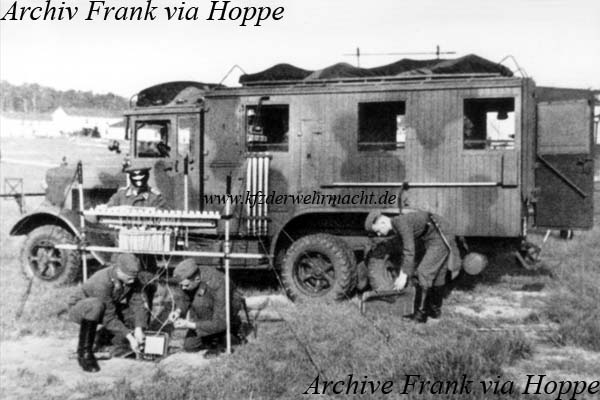 A Fernsprechbetriebskraftwagen - telephone operating motor vehicle - (Kfz. 72) on a chassis of a Henschel type 33 D 1 with geschlossener Aufbau 6. There were significant differences in the case of superstructures based on different manufacturers chassis because of different size and proportion. A Fernsprechbetriebskraftwagen - telephone operating motor vehicle - (Kfz. 72) on a chassis of a Henschel type 33 D 1 with geschlossener Aufbau 6. There were significant differences in the case of superstructures based on different manufacturers chassis because of different size and proportion.
|
|
|
|
|
|
|
|
Furthermore it can be concluded based on the H.Dv. 398 K & K1 that no seperate numbers for the special superstructures developed in the second half of the 1930s were assigned. Most probably, the construction of the special superstructure was defined by the Kfz. number. Especially this applies to vehicles based on the Einheitsfahrgestelle which were delivered to the troop commencing in 1936. Because of the usage of these standardised chassis, no adjustments to different chassis was necessary.
|
|
|
|
|
|
|
|
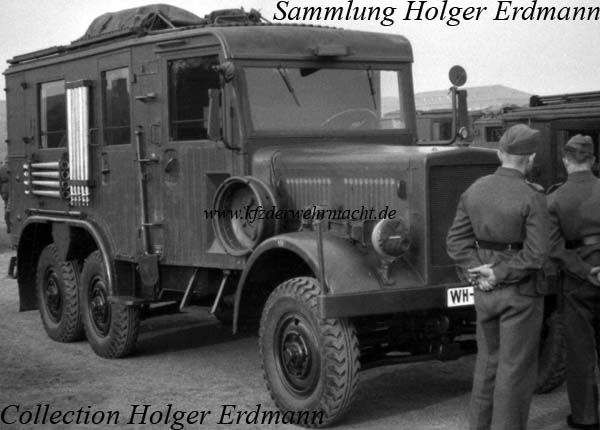 As an example, a Fernsprechbetriebskraftwagen (Kfz. 61) mit Einheitsfahrgestell für l. Lkw. is shown. The geschlossener Aufbau was still made with Stabbrettern. As an example, a Fernsprechbetriebskraftwagen (Kfz. 61) mit Einheitsfahrgestell für l. Lkw. is shown. The geschlossener Aufbau was still made with Stabbrettern.
|
|
|
|
|
|
|
|
Overal, the developed closed superstructures of the peacetime were tried and tested. But they were to heavy and expensive in the production. At the outbreak of World War II, the situation was as follows: In the case of the l. gl. Lkw. (o), the production of the Büssing-NAG G 31, the Magirus M 206 and the Mercedes-Benz G 3 a was run out. They had been replaced by the l. gl. Lkw. (Einheitsdiesel) but the end of production of the ordered 14,500 exemplars was in near future. The Krupp L 2 H 143 was still in production but this chassis was too weak for the heavy superstructures of the Kfz. 61 and 62. In the case of the m. gl. Lkw. (o) only the Henschel type 33 and the Mercedes-Benz LG 3000 were still in production but the production of the latter should run out in 1940. The development of a m. gl. Lkw. (Einheitsfahrgestell) failed. A solution to keep production of motor vehicles with closed superstructures in the different sizes up on the required level was urgently needed. Corresponding ducuments about what dicisions were made could not be found so far. It seems that the Luftwaffe went their own way - like they did it many times bevore. But first to the army. To bridge the gap, commercial motor vehicles of the Schell-Plan with quickly developed respectively adapted commercial closed superstructures were procured.
|
|
|
|
|
|
|
|
 In photos often identifiable is this Opel Blitz 3,6-36 S with closed superstructure. The photos date mainly from 1941 and later. Based on a photo analysis, these vehicles were mainly used in the permanent posts of the Kfz. 61. Such a vehicle could only be found in one technical manual. In the D 1315 from 15th January 1943, the vehicle is designated as m. Lkw. (o) mit geschlossenem Sonderaufbau - medium lorry (commercial) with closed special superstructure. In photos often identifiable is this Opel Blitz 3,6-36 S with closed superstructure. The photos date mainly from 1941 and later. Based on a photo analysis, these vehicles were mainly used in the permanent posts of the Kfz. 61. Such a vehicle could only be found in one technical manual. In the D 1315 from 15th January 1943, the vehicle is designated as m. Lkw. (o) mit geschlossenem Sonderaufbau - medium lorry (commercial) with closed special superstructure.
|
|
|
|
|
|
|
|
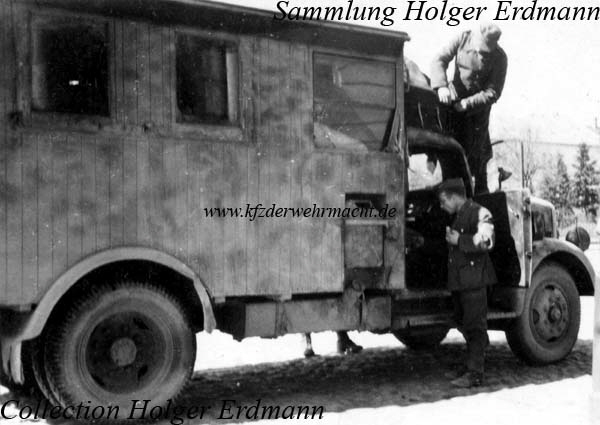 Borgward delivered its 3 ton model Benzin respectively Diesel G.W. with closed superstructure made from Stabbrettern in the year 1941 and most probably also later for the Wehrmacht. Most of the vehicles were used as Sammlerkraftwagen - battery charger motor vehicle - (Kfz. 42). But there were also some Funkkraftwagen (Kfz. 61). Later production models had the new design of the closed superstructures consisting of a framework construction with fibreboard planking. Borgward delivered its 3 ton model Benzin respectively Diesel G.W. with closed superstructure made from Stabbrettern in the year 1941 and most probably also later for the Wehrmacht. Most of the vehicles were used as Sammlerkraftwagen - battery charger motor vehicle - (Kfz. 42). But there were also some Funkkraftwagen (Kfz. 61). Later production models had the new design of the closed superstructures consisting of a framework construction with fibreboard planking.
|
|
|
|
|
|
|
|
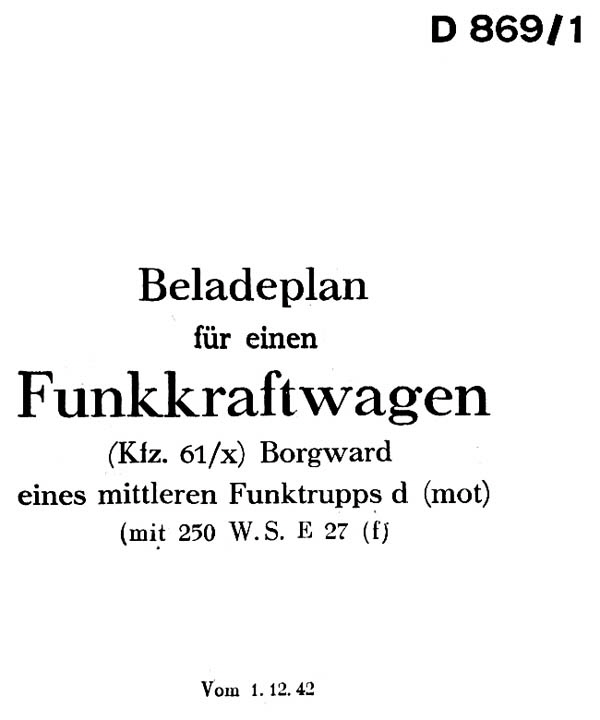 Besides photographic evidence for the geschlossener Borgward Aufbaus as Funkkraftwagen there is also the Beladeplan D 869/1 as evidence. Besides photographic evidence for the geschlossener Borgward Aufbaus as Funkkraftwagen there is also the Beladeplan D 869/1 as evidence.
|
|
|
|
|
|
|
|
Obviously, the company Opel got a contract for the development of a geschlossener Aufbau - closed superstructure - based on the Opel Blitz 3,6-6700 A 3 ton lorry. Anyhow, this type of closed superstructure in the three ton payload class can only be found on this chassis. Similar closed superstructures were developed also for the payload classes 1.5 ton and 4.5 ton. In these cases, the development companies could not be identified so far. In these payload classes, the closed superstructures were built up on different chassis.
|
|
|
|
|
|
|
|
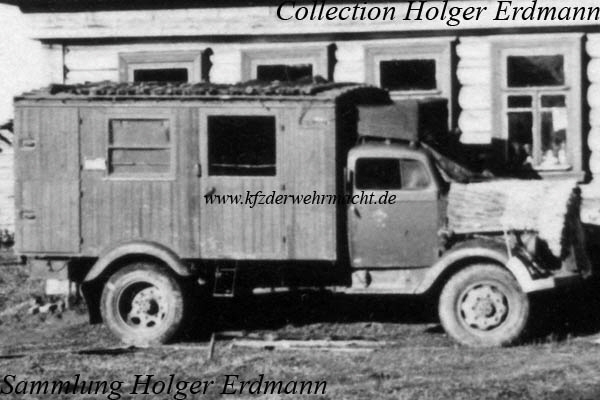 It seems that the development of this superstructure was already started in 1940 or early 1941. The first trial superstructures were still constructed in the old design with Stabbrettern. Photographic evidence is starting in summer 1941. Basically the geschlossener Aufbau had two windows in the left side, a door with window in the backside, a window and a door with window in the right side and a small window to the driver’s cab in the frontside. There were stowage compartmets one above the other in both sides with nearly quadratic doors. This is a typical distinguishing feature compared to the similar LC-Koffer of the Luftwaffe. It seems that the development of this superstructure was already started in 1940 or early 1941. The first trial superstructures were still constructed in the old design with Stabbrettern. Photographic evidence is starting in summer 1941. Basically the geschlossener Aufbau had two windows in the left side, a door with window in the backside, a window and a door with window in the right side and a small window to the driver’s cab in the frontside. There were stowage compartmets one above the other in both sides with nearly quadratic doors. This is a typical distinguishing feature compared to the similar LC-Koffer of the Luftwaffe.
|
|
|
|
|
|
|
|
 For the production series, the design of the LC-Koffer of the Luftwaffe was borrowed. Now the geschlossener Aufbau was designed as a timber frame construction with fibreboard planking. The superstructure had a clear height of 1,525 mm and was dismountable. The sidewals were screwed together and were screwed to the bottom. There was also a more domed roof besides the slightly domed standard roof. The roofs were fixed by ten Spannverschlüsse - tension locks -, each three on the side walls and each two at the front and rear walls. For the production series, the design of the LC-Koffer of the Luftwaffe was borrowed. Now the geschlossener Aufbau was designed as a timber frame construction with fibreboard planking. The superstructure had a clear height of 1,525 mm and was dismountable. The sidewals were screwed together and were screwed to the bottom. There was also a more domed roof besides the slightly domed standard roof. The roofs were fixed by ten Spannverschlüsse - tension locks -, each three on the side walls and each two at the front and rear walls.
|
|
|
|
|
|
|
|
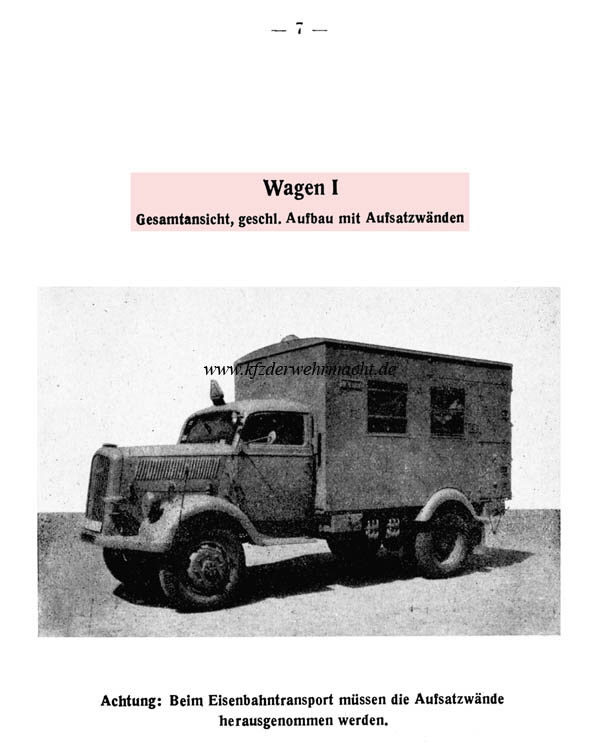 Mainly for the purpose as Werkstattkraftwagen - workshop motor vehicles - there were Aufsatzwände - attachment walls - to increase the clear hight. Because of that, it could be worked in standing position inside. The Aufsatzwände were fixed by tension locks, too. For the rail transport of the vehicle, the Aufsatzwände had to be dismantled. The illustrated side of the D 622/1 shows an Opel Blitz 3,6-6700 A as Wagen I of the Kfz. Instandsetzungs-Staffel. Observe the term geschlossener Aufbau mit Aufsatzwänden. The geschlossener Aufbau of the army could be used for various purposed by using different equipment sets. Mainly for the purpose as Werkstattkraftwagen - workshop motor vehicles - there were Aufsatzwände - attachment walls - to increase the clear hight. Because of that, it could be worked in standing position inside. The Aufsatzwände were fixed by tension locks, too. For the rail transport of the vehicle, the Aufsatzwände had to be dismantled. The illustrated side of the D 622/1 shows an Opel Blitz 3,6-6700 A as Wagen I of the Kfz. Instandsetzungs-Staffel. Observe the term geschlossener Aufbau mit Aufsatzwänden. The geschlossener Aufbau of the army could be used for various purposed by using different equipment sets.
|
|
|
|
|
|
|
|
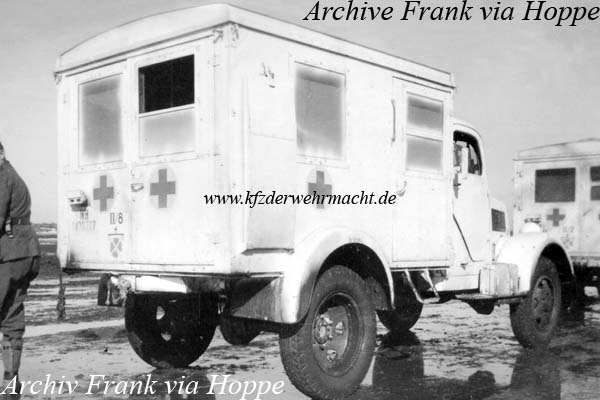 There were two versions of the closed superstructure in the 1.5 ton class. According to the usage, the number of windows and their position differed. In the usage as Krankenkraftwagen (Kfz. 31) there was one window in the middle of the left side, a two winged door with two windows in the rear side and a window and a door with window in the right side. In the usage as Funkkraftwagen - radio motor vehicle - and other communication vehicles the window in the right side was missing and the windo in the left side was replaced further to the front. In the rear side there was a small window and a large two winged door for a stowage compartment. A recess for a spare wheel was located in the forward left side in the case of both variants. These superstructures were used on the chassis of the Phänomen Granit 1500 S & 1500 A and the Steyr 1500 A / 2000 A. It seems that there were only trial superstructures based on the chassis of the Mercedes-Benz L 1500 A. There were two versions of the closed superstructure in the 1.5 ton class. According to the usage, the number of windows and their position differed. In the usage as Krankenkraftwagen (Kfz. 31) there was one window in the middle of the left side, a two winged door with two windows in the rear side and a window and a door with window in the right side. In the usage as Funkkraftwagen - radio motor vehicle - and other communication vehicles the window in the right side was missing and the windo in the left side was replaced further to the front. In the rear side there was a small window and a large two winged door for a stowage compartment. A recess for a spare wheel was located in the forward left side in the case of both variants. These superstructures were used on the chassis of the Phänomen Granit 1500 S & 1500 A and the Steyr 1500 A / 2000 A. It seems that there were only trial superstructures based on the chassis of the Mercedes-Benz L 1500 A.
|
|
|
|
|
|
|
|
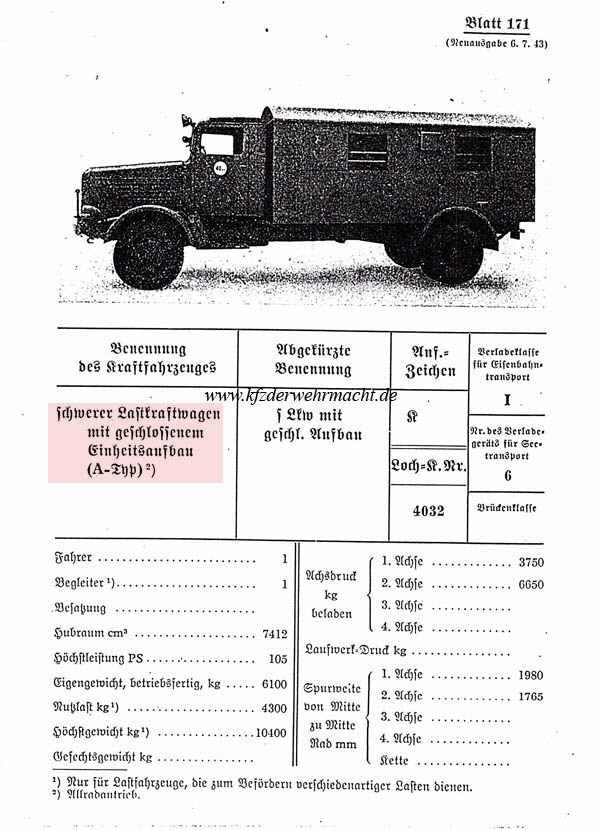 Only one variant of the closed superstructure was made in the class of the 4.5 ton lorries. Two windows were located in the left side, a door with window in the rear side and a window and a door with window in the right side. Each one large door for a stowage compartment was located in the left and the right side. According to the usage, there were additional doors to stowage compartments. Aufsatzwände - attachment boards - were also available for this superstructure. The closed superstructure in the 4.5 ton class was used on the chassis of the Büssing-NAG 500 A, Büssing-NAG 4500 S & 4500 A, the Mercedes-Benz L 4500 S & L 4500 A and the MAN ML 4500 S & ML 4500 A. The designation geschlossener Einheitsaufbau - closed standard superstructure - can only be found in the D 600 from 6th July 1943. Only one variant of the closed superstructure was made in the class of the 4.5 ton lorries. Two windows were located in the left side, a door with window in the rear side and a window and a door with window in the right side. Each one large door for a stowage compartment was located in the left and the right side. According to the usage, there were additional doors to stowage compartments. Aufsatzwände - attachment boards - were also available for this superstructure. The closed superstructure in the 4.5 ton class was used on the chassis of the Büssing-NAG 500 A, Büssing-NAG 4500 S & 4500 A, the Mercedes-Benz L 4500 S & L 4500 A and the MAN ML 4500 S & ML 4500 A. The designation geschlossener Einheitsaufbau - closed standard superstructure - can only be found in the D 600 from 6th July 1943.
|
|
|
|
|
|
|
|
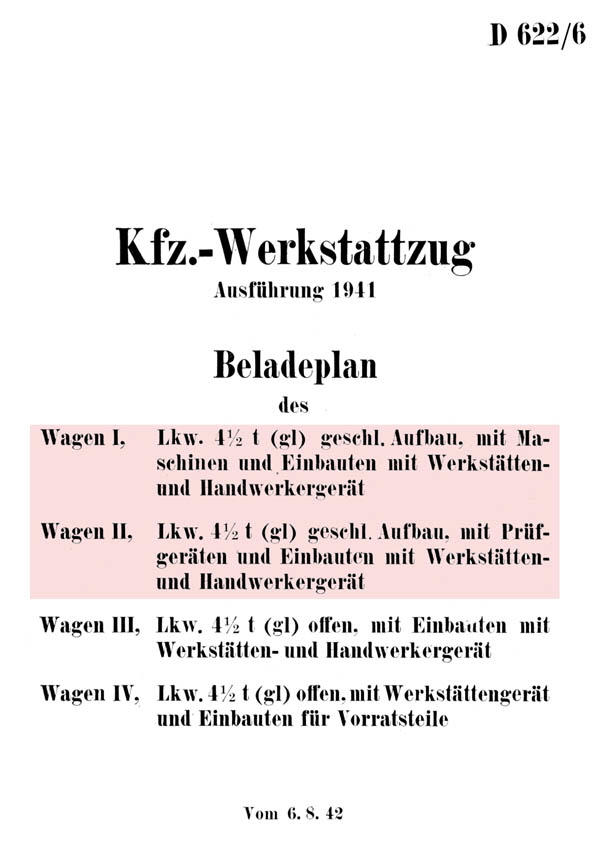 In all other known manuals the closed superstructure is designated as geschlossener Aufbau, like for example in the illustrated D 622/6 from 6th August 1942. In all other known manuals the closed superstructure is designated as geschlossener Aufbau, like for example in the illustrated D 622/6 from 6th August 1942.
|
|
|
|
|
|
|
|
Like in many other cases too, the Luftwaffe developed a life of its own besides the other branches of the Wehrmacht. Apparently without their knowledge, the Luftwaffe developed the LC-Koffer as replacement for the old style closed superstructures. The LC stood for a development office of the Luftwaffe. The design of the LC-Koffer was almost revolutionary simple. Seemingly the first exemplars were delivered to the troop already in 1939. Anyhow, the first loading plan L.Dv. 702/2 Heft 201 has the date 18th August 1939. At first only used by the Luftwaffe, it was later used by all other branches of the Wehrmacht.
|
|
|
|
|
|
|
|
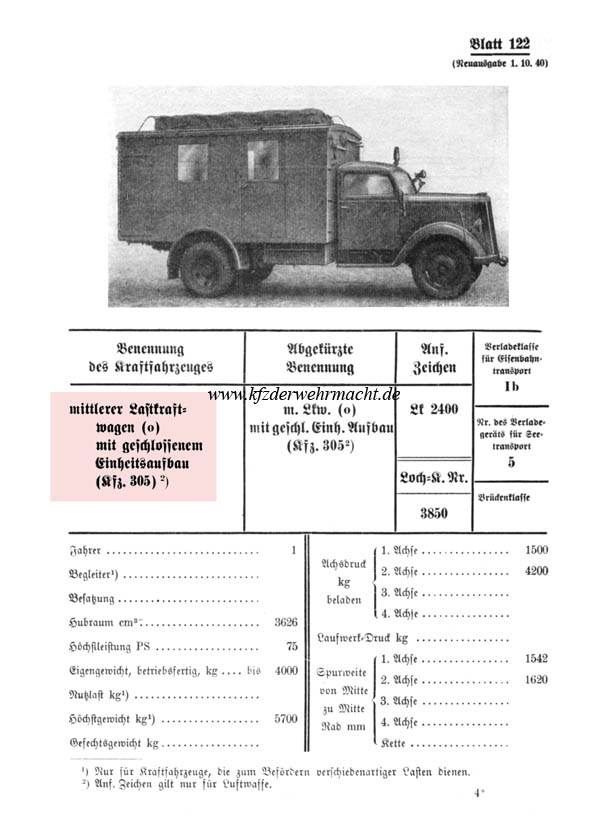 The so-called LC-Koffer of the Luftwaffe was constructed from light-boards and was decomposable. It had a wall thicknes of 30 mm whereby the construction timbers for the mounting of equipment were uniformly arranged. Also the arrangement of hatches, windows and doors was standardised. There was a Schiebefenster - sliding window - in the forward wall behind the rear window of the driver’s cab. Two Klappen - flaps - 1,270 x 520 mm (at the front and the back) as well as a Fenster - window - and an Übersetzfenster - sliding window - were arranged in the left side of the box body. One Tür 1,545 x 700 mm mit Fenster - door with window - was centrical located in the backside. A further Tür 1,545 x 700 mm mit Fenster was located in the right side of the box body. Behind this, a further Übersetzfenster and eine Klappe 1,270 x 500 mm was arranged. There were two different roofs available. The Dach mit Dachgalerie mit Plane und Spriegeln - roof with railing with tarpaulin and hoops - (see photo) and the Laufgangdach - gallery roof - with a headroom of 1,890 mm. The raised fixture of the Laufgangdach had small windows in the sides. The so-called LC-Koffer of the Luftwaffe was constructed from light-boards and was decomposable. It had a wall thicknes of 30 mm whereby the construction timbers for the mounting of equipment were uniformly arranged. Also the arrangement of hatches, windows and doors was standardised. There was a Schiebefenster - sliding window - in the forward wall behind the rear window of the driver’s cab. Two Klappen - flaps - 1,270 x 520 mm (at the front and the back) as well as a Fenster - window - and an Übersetzfenster - sliding window - were arranged in the left side of the box body. One Tür 1,545 x 700 mm mit Fenster - door with window - was centrical located in the backside. A further Tür 1,545 x 700 mm mit Fenster was located in the right side of the box body. Behind this, a further Übersetzfenster and eine Klappe 1,270 x 500 mm was arranged. There were two different roofs available. The Dach mit Dachgalerie mit Plane und Spriegeln - roof with railing with tarpaulin and hoops - (see photo) and the Laufgangdach - gallery roof - with a headroom of 1,890 mm. The raised fixture of the Laufgangdach had small windows in the sides.
|
|
|
|
|
|
|
|
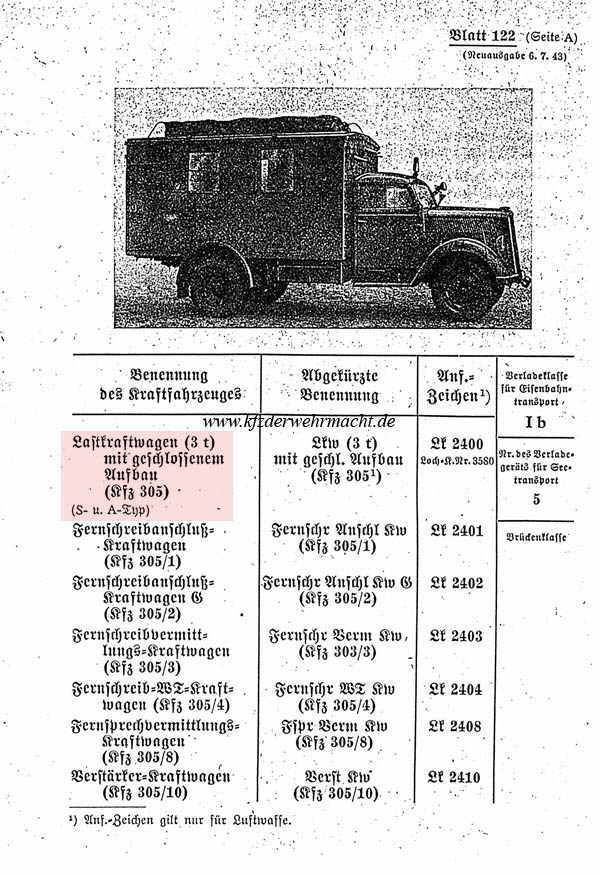 In the D 600 from 1st October 1940 the vehicles were designated as mittlerer Lastkraftwagen (o) mit geschlossenem Einheitsaufbau- medium lorry (commercial) with closed standard superstructure -, abgekürzt - abbreviated - m. Lkw. (o) mit geschl. Einh. Aufbau (Kfz. 305). In the new edition of the D 600 from 6th July 1943 there are some additional sheets with the superstructure variants. There one can find the designation Lastkraftwagen (3t) mit geschlossenem Aufbau (Kfz. 305). In contrast to that, one can find in the Geräte-Handbuch - technical manual - to the superstructure D.(Luft)T. 8203 from 16th October 1941 the designation geschlossener Einheits-Aufbau der Luftwaffe zerlegbar auf m. Lkw. (o) LC-Koffer (mot) Kfz. 305/... In the D 600 from 1st October 1940 the vehicles were designated as mittlerer Lastkraftwagen (o) mit geschlossenem Einheitsaufbau- medium lorry (commercial) with closed standard superstructure -, abgekürzt - abbreviated - m. Lkw. (o) mit geschl. Einh. Aufbau (Kfz. 305). In the new edition of the D 600 from 6th July 1943 there are some additional sheets with the superstructure variants. There one can find the designation Lastkraftwagen (3t) mit geschlossenem Aufbau (Kfz. 305). In contrast to that, one can find in the Geräte-Handbuch - technical manual - to the superstructure D.(Luft)T. 8203 from 16th October 1941 the designation geschlossener Einheits-Aufbau der Luftwaffe zerlegbar auf m. Lkw. (o) LC-Koffer (mot) Kfz. 305/...
|
|
|
|
|
|
|
|
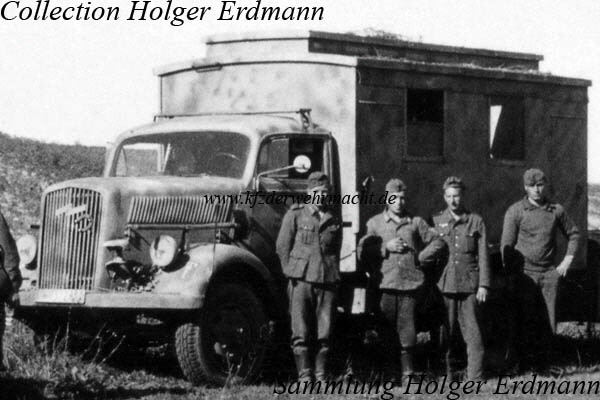 An Opel Blitz 3,6-6700 A with LC-Koffer with Laufgangdach. Until now, the LC-Koffer of the Luftwaffe could be proven on the chassis of the Borgward B 3000 S & B 3000 A, the Ford V8 3t model 1939 & V 3000 S, the Klöckner-Deutz S 3000 & A 3000, the Mercedes-Benz L 3000 S & L 3000 A and the Opel Blitz 3,6-36 S & 3,6-6700 A by photo evidence. An Opel Blitz 3,6-6700 A with LC-Koffer with Laufgangdach. Until now, the LC-Koffer of the Luftwaffe could be proven on the chassis of the Borgward B 3000 S & B 3000 A, the Ford V8 3t model 1939 & V 3000 S, the Klöckner-Deutz S 3000 & A 3000, the Mercedes-Benz L 3000 S & L 3000 A and the Opel Blitz 3,6-36 S & 3,6-6700 A by photo evidence.
|
|
|
|
|
|
|
|
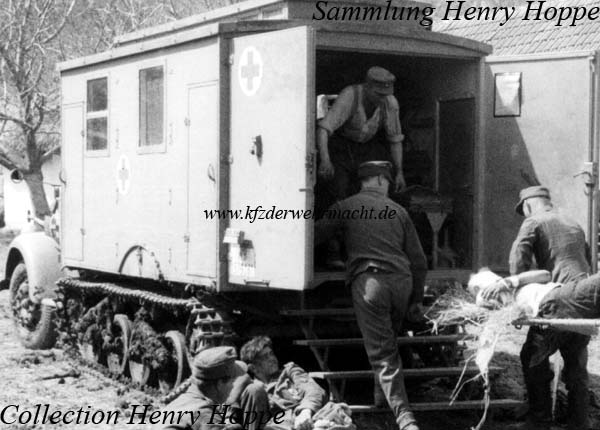 The Krankenkraftwagen - ambulances - on chassis of the 3 ton lorries had a modified LC-Koffer with Laufgangdach. There was a large two winged door in place of the rear wall. Broad stairs simplified the mounting and dismounting There were no stowage bins built in to create more space for the racks for the stretchers. This superstructure was used by all branches. Besides different 3 ton lorries, Krankenkraftwagen were also built up on the chassis of the Gleisketten Lastkraftwagen 2t mit geschlossenem Aufbau (Sd. Kfz. 3/4). The Krankenkraftwagen - ambulances - on chassis of the 3 ton lorries had a modified LC-Koffer with Laufgangdach. There was a large two winged door in place of the rear wall. Broad stairs simplified the mounting and dismounting There were no stowage bins built in to create more space for the racks for the stretchers. This superstructure was used by all branches. Besides different 3 ton lorries, Krankenkraftwagen were also built up on the chassis of the Gleisketten Lastkraftwagen 2t mit geschlossenem Aufbau (Sd. Kfz. 3/4).
|
|
|
|
|
|
|
|
Conclusion: Terms like Funkkoffer - radio box - and Einheitskoffer - standard box - were provably not used in the relevant technical manuals and documents. In addition, the term Funkkoffer is misleading - a view onto the Kfz. number list and the variety usages of the Kfz. 305 makes that clear. A large part of the Kfz. 305 had nothing to do with radio or other communication. In contrast to that, the term geschlossener Aufbau - closed superstructure - was already used by the Reichswehr in a large part of the technical manuals like loading plans, installation manuals or equipment proofs. Interchangably the term geschlossener Einheits-Aufbau was used in some cases in the second half of the war.
|
|
|
|
|
|
|
|
- - - - - - - - - - - - - - -
|
|
|
|
|
|
|
|
<< back to the articles
|
|